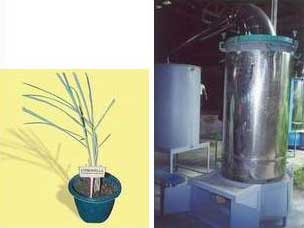| PJS Vol 130 No. 2, December 2001 | |
| Page 75-87 | |
| ISSN 0031-7683 |
Citronella (Cymbopogon winterianus) Oil Industry Challenges and Breakthroughs
Rosalinda C. Torres1* and Barbara DJ. Tio2
1Chemicals and Minerals Division
Industrial Technology Development Institute
Bicutan, Taguig, Metro Manila
2Rural Technology and Information Division
Industrial Technology Development Institute
Bicutan, Taguig, Metro Manila

The picture (above) is a citronella plant which probably first cultivated in Sri Lanka, is now widely grown throughout Asia and in some parts of Central and South America. It thrives well under tropical and subtropical climate with abundant moisture and sunshine. The pioneering research on its oil extraction was done at the National Institute of Science and Technology (now Industrial Technology Development Institute (ITDI) in the early 1980s (Coronel, 1984). The technology of extracting citronella oil can be classified as agro-based and generally as clean technology. Aside from being an import-substitute, the citronella oil or essential oils, in general, has export potential and its production can utilize rural sector participation.
Citronella oil is the volatile aromatic mixture derived from citronella grass. The pioneering research on its extraction was done at the National Institute of Science and Technology (now Industrial Technology Development Institute (ITDI) in the early 1980s (Coronel 1984). The technology of extracting citronella oil can be classified as agro-based and generally as clean technology. Aside from being an import-substitute, the citronella oil or essential oils, in general, has export potential and its production can utilize rural sector participation. The initial attempt to commercialize this technology through the technology transfer scheme was done by the Institute in mid-1980s (Uriarte 1984). The commercialization of extracting citronella oil resulted in the establishment of small-scale citronella oil extraction facilities in the different regions of the country (see Appendix A). Despite the establishment of small-scale citronella oil production units in the regions, the impact of this industry was hardly recognized in the early 1990s. This industry suffered setbacks in the past due to the following constraints: inconsistency in the quality and quantity of extracted oils, inavailability of fabricators in the project site, lack of prototype distillation set-up, fluctuating market price and limitation of market to small scale soap manufacturers rather than to huge industrial users. Oftentimes, the problem is aggravated by the lack of technical and managerial skills of the technology adapter. Recently, the prospect of this industry is gradually making grounds with the incorporation of the Quintessence Oils, Inc. in May 9, 1996. This Corporation, mostly composed of essential oil producers, is engaged in buying citronella oil from small-scale producers at a competitive price, thus, assuring farmers of ready market for their extracted citronella oil. Moreover, the ITDI has now completed the fabrication of its steam-distilled extraction unit, which is intended to be used for training purposes, and for trial runs of interested entrepreneurs.
REFERENCES
CORONET VQ, ANZALDO FE, RECANA MP. 1984. Effect of Moisture Content on the Essential Oil Yield of Lemongrass and Citronella. NSTA Technology Journal 9(3).
IRUTHAYATHAS EE et al. 1977. Variations in the Composition of Oil in Citronella. Journal of the National Science Council of Sri Lanka 5(2).
KEULERS SGAJ, SPOORENBERG CL eds. 1991. CBI Essential Oils and Oleoresins. A Study of the Netherlands and Other Major Markets in the European Community. Market Study— Essential Oils and Oleoresins: A Study of Selected Producers and Major Markets, 1996. International Trade Center UNCTAD/GATT Geneva.
OYEN LPA, NGUYEN XUAN DUNG. 1999. Plant Resources of Southeast Asia No. 19 Essential Oil Plants. Backhuys Publishers. Leiden.
ROBBINS SRJ. 1993. Selected Markets for the Essential Oils of Lemongrass, Citronella & Eucalyptus. Tropical Products Institute 6171 London.
URiARTE FA Jr. 1984. Technology Transfer and the Recognition of Opportunity. NIST Journal 1(1).
WIJESEKERA ROB. ed. Practical Manual on the Essential Oils Industry. Produced by the Thailand Institute of Scientific and Technological Research with Collaboration from the Central Institute of Medicinal and Aromatic Plants for the United Nations Industrial Development Organization (UNIDO). Bangkok, Thailand.
1997. Foreign Trade Statistics of the Philippines.









